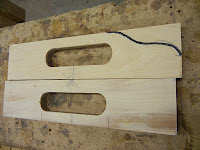A television series made in 1967 and 68 called Cowboy in Africa was shot in Kenya. It led
to a Hollywood movie, starring Chuck
Connors playing world champion cowboy Jim Sinclair. You can see a YouTube clip
for the opening scenes here.
(WARNING The scenes are not exactly animal welfare friendly). In my rating system the movie would not score many stars, if any. There used to be "B" movies that were shown before the main event. This one might not have even qualified for such a position.
My friend Tony
Parkinson, with whom I worked on several projects through the late 60s and
early 70s was not only the animal advisor but also the film double for several
scenes that involved animal capture.
 |
| Tony (blue shirt) and I prepare darts in Rwanda for an elephant translocsion |
 Below left Tony appears in an old Candanian Club whisky advert shot in the days before drugs were used to capture rhino. I began workingwith him a few months after the scene was shot.
Below left Tony appears in an old Candanian Club whisky advert shot in the days before drugs were used to capture rhino. I began workingwith him a few months after the scene was shot.
In almost all of the roping scenes in the movie it is
Tony, not Connors, who is on the horse and twirling the lariat. He learned to
use one from the real cowboys who also came on the set and worked in several
scenes.
One of the animal stars was a rhino that Tony had captured
earlier and held in a pen for the movie scenes. Unfortunately, before the
filming was over, the rhino broke his horn off very near the base and so there
was a bit of a crisis. He could no longer perform and be accepted by the
audience. Solution? Well, Tony had a second skill. He was a boat builder and
skilled craftsman. Building a fiberglass replacement horn, and gluing it on
with a 5-minute epoxy resin (a version called Araldite was the only one available in Kenya at the time) was no
problem.
Fast-forward 45 years and we have more dummy rhino horns
being built, but for an entirely different reason. Nowadays museums are having to
resort to subterfuge in an effort to deal with theft. In another case in South Africa a would-be thief was fooled by
more fiberglass, in this case it was an entire synthetic head, which is now
hornless.
There have been recent convictions (and some jail sentences)
for other would-be and successful museum thieves in England, Spain, and Germany but in these and no doubt other cases
the horns were real.
The most impressive sentence was handed down in South
Africa, when a Thai man named Chumlong Lemtongthai
was convicted of rhino poaching linked to prostitution and sentenced to 40
years.
The material is so valuable (double the price of gold) that
the temptation is obviously severe.
Next week I will take a close look at the new(ish) efforts
at prevention, including reports from Swara
the magazine arm of the East AfricanWildlife Society, which arrived in the post yesterday. I need time to organize my thoughts on these
issues and of course to prepare the goose for Tuesday’s lunch time bash with
family.






















